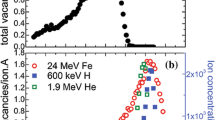Abstract
In this paper, an investigation on the micro-structure of an Fe-base oxide-dispersion-strengthened (ODS) alloy irradiated with high-energy 20Ne ions to different doses at a temperature around 0.5T m (T m is the melting point of the alloy) is presented. Investigation with the transmission electron microscopy found that the accelerated growth of voids at grain-boundaries, which is usually a concern in conventional Fe-base alloys under conditions of inert-gas implantation, was not observed in the ODS alloy irradiated even to the highest dose (12000 at.ppm Ne). The reason is ascribed to the enhanced recombination of point defects and strong trapping of Ne atoms at the interfaces of the nano-scale oxide particles in grains. The study showed that ODS alloys have good resistance to the high-temperature inter-granular embrittlement due to inert-gas accumulation, exhibiting prominence of application in harsh situations of considerable helium production at elevated temperatures like in a fusion reactor.
Similar content being viewed by others
References
Ullmaier H. Introductory remarks-Helium in metals. Radiat Eff, 1983, 78: 1–10
Wang P X. Behavior of helium in metals and helium embrittlement in stainless steels. Nucl Sci Eng, 1989, 19(2): 119–130
Benjamin J S. Dispersion strengthened superalloys by mechanical alloying. Metall Trans, 1970, 1: 2943–2951
Ukai S, Nishida T, Okada H, et al. Development of oxide dispersion strengthened ferritic steels for FBR core application (I). J Nucl Sci Tech, 1997, 34(3): 256–263
Klueh R L, Shingledecker J P, Swindeman R W, et al. Oxide dispersion strengthened steels: A comparison of some commercial and experimental alloys. J Nucl Mater, 2005, 341: 103–114
Ukai S, Mizuta S, Yoshitake T, et al. Tube manufacturing and characterization of oxide dispersion strengthened ferritic steels. J Nucl Mater, 2006, 283: 702–706
Kimura A, Cho H S, Toda N, et al. High burnup fuel cladding materials R&D for advanced nuclear systems: Nano-sized oxide dispersion strengthened steels. J Nucl Sci Tech, 2007, 44: 323–328
Kim I S, Hunn J D, Nashimoto N, et al. Defect and void evolution in oxide dispersion strengthened ferritic steels under 3.2 MeV Fe+ ion irradiation with simultaneous helium injection. J Nucl Mater, 2000, 280: 264–274
Marochov N, Goodhew P J. A comparison of the growth of helium and neon bubbles in nickel. J Nucl Mater, 1998, 158: 81–86
Ziegler J F, Biersack J P, Littmark U. The Stopping and Range of Ions in Solids. New York: Pergamon Press, 1984
Klimiankou M, Lindau R, Möslang A. TEM characterization of structure and composition of nanosized ODS particles in reduced activation ferritic-martenstic steels. J Nucl Mater, 2004, 329–333: 347–351
Trinkaus H. On the modeling of the high-temperature embrittlement of metals containing helium. J Nucl Mater, 1983, 118: 39–49
Singh B N, Trinkaus H. An analysis of the bubble formation behavior under different experimental conditions. J Nucl Mater, 1992, 186: 153–165
Lee E H, Mansur L K. Unified theoretical analysis of experimental swelling data for irradiated austenitic and ferritic/martenstic steels. Metall Trans A, 1990, 21: 1021–1035
Zhang C H, Chen K Q, Wang Y S, et al. Helium diffusion and helium bubble formation in metals. Nucl Phys Rev, 2001, 18(1): 50–55
Williams D B, Carter C B. Transmission Electron Microscopy. New York and London: Plenum Press, 1996. 321–323
Author information
Authors and Affiliations
Corresponding author
Additional information
Supported by the NSAF Joint Foundation of China (Grant No. 10376039) and the KOFST Program of Korea (South) for Visiting Scientists
About this article
Cite this article
Zhang, C., Jang, J.S., Yang, Y. et al. A study of the suppression of the high-temperature helium embrittlement in an oxide-particle dispersion strengthened alloy. Chin. Sci. Bull. 53, 3416–3421 (2008). https://doi.org/10.1007/s11434-008-0446-7
Received:
Accepted:
Published:
Issue Date:
DOI: https://doi.org/10.1007/s11434-008-0446-7




